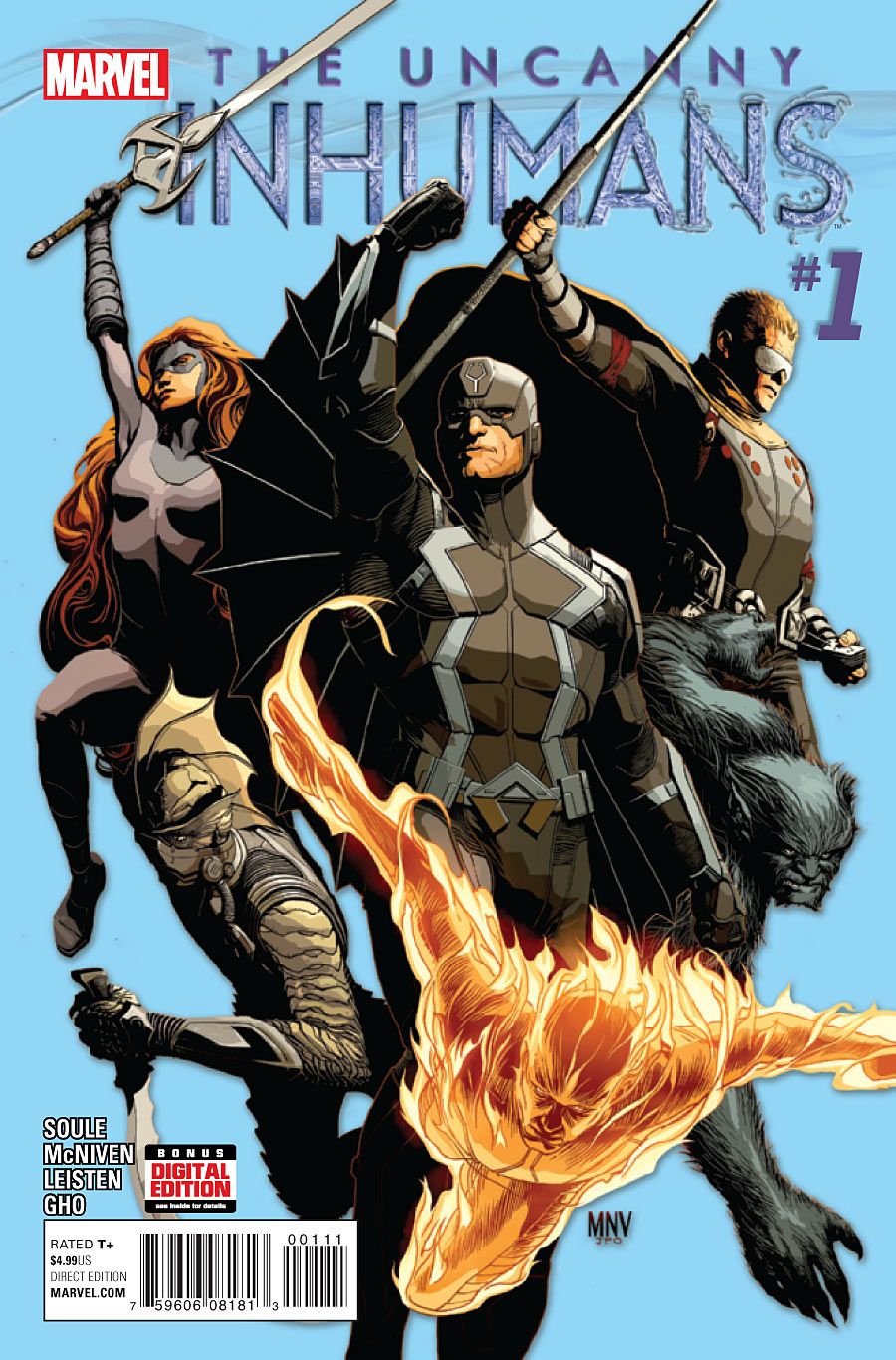Charles Soule, Steve McNiven and Jay Leisten's "Uncanny Inhumans" #1 presents the first steps into the Inhumans' post-"Secret Wars" existence. The creative team introduces readers to the Inhumans with a trademark trio: the Inhumans' Once (and Current?) King, Black Bolt; the amphibious Triton; and one of Soule's contributions to the Inhuman mythology, Reader (as well as his dog Forey). Soule picks up from the Free Comic Book Day story and sends the trio on the trail of Ahura, which -- naturally -- leads to a conflict with Kang.
In this debut issue, Kang does little more than twirl his hypothetical mustache, unleashing a set of time-torn threats on the Inhuman scouting party, but Soule makes it quite clear the conflict between Kang and the Inhumans is deep and wide. I've personally hankered for a story that takes a sharper investigation of Kang as a character, and Soule seems ready to deliver on that. The writer makes some strong choices in his trio, giving readers a nice variety of characters and voices before bouncing back to Manhattan and the greater portion of the Inhumans, who are led by Medusa. Soule brings Medusa down from her lofty perch, making her a sympathetic character despite her post and her holier-than-thou attitude.
McNiven's art is lovely. Leisten's inks hit the right notes, adding texture and depth throughout and giving McNiven's drawings just the right boost. McNiven has such a sublime command of detail and nuanced character expression that the art in this comic just seems to flow from one panel to the next. The artist is not at all intimidated by the trio that launch the issue; it's never the easiest to capture expressions with mute, Braille-reading and half-cloaked characters, but McNiven tells the story of Black Bolt through his body language. Triton, whose design seems influenced by "The Creature from the Black Lagoon," tends to work through dramatic gestures and Reader has the benefit of editorial captions neatly tucked into place by letterer Clayton Cowles. Soule also adds in Beast, giving McNiven a visually commanding character to have a little more fun with. Sunny Gho's colors are bright and bold, luminous around and through McNiven's art.
The initial tale in "Uncanny Inhumans" #1 serves up bits and pieces, not unlike a movie trailer, giving readers snippets of a wide span of Inhuman and NuHuman happenings. A ten-page backup follows that tale; Soule scripts this story as well, focusing on the NuHumans training under Gorgon, who is still suffering from some life-changing injuries. Presumably, this yarn peeks into what readers can expect from the upcoming "All-New Inhumans" Soule is slated to co-write with James Asmus.
Brandon Peterson draws the backup in "Uncanny Inhumans" #1, which is smooth and sharp, finely detailed and pleasant. Unfortunately, it has some bizarre, unnecessarily over-the-top coloring choices from Nolan Woodard, like green skies over a marketplace in Morocco, despite the complete lack of conflict that could shade the environment. Those colors work for the concept of the Inhumans, but -- when men in shirts and khakis look more alien because of their surroundings -- it throws the story off. Peterson's art is crisp, but his rendition of Flint is so very far away from McNiven's take earlier in "Uncanny Inhumans" #1 that they could be separate characters.
As much as Marvel is banking on the Inhumans, they really should do a better job of shepherding the property. Despite being a fun, world-building examination, "Uncanny Inhumans" #1 gets tripped up by quality control. For instance, "Uncanny Inhumans" #1 cites Steve McNiven as inker. What's more, a pair of the pages in the backup seem out of order, which ruptures the story flow. This could be attributed to a storytelling choice, but it comes across as an error and -- combined with the fumbled credits -- just makes "Uncanny Inhumans" #1 look unnecessarily rushed when it should have been completely polished and shiny.

